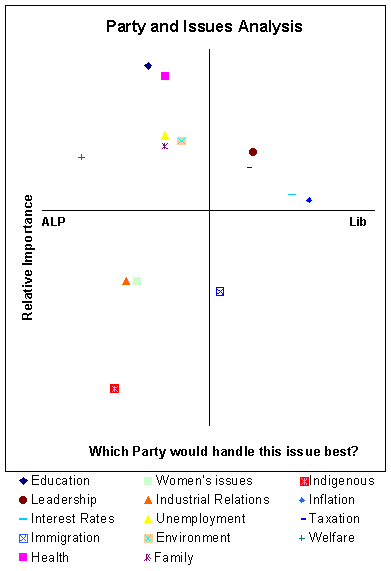John Howard has recently been looking very relaxed and comfortable. There is no obvious reason why he should. The political landscape does not favour his re-election. Neither do the entrails of the public opinion polls. And none of the Government’s publicly visible policies look like election winners either. But that doesn’t mean that things won’t change.
First to the opinion polls. The Roy Morgan organisation recently reported that the Liberal Party had recorded its lowest poll rating ever in June 2000. Only 30% of electors were going to vote Liberal. This rose to 33.5% when the National Party vote was added in, and to 40% on a two-party preferred basis. This was not a one-off result. The combined coalition vote has been tracking below 40% from 1998 to the present. The attached graph shows the two-party preferred vote for this year, with the government never pulling ahead of the Opposition.

Advertisement
The Morgan figures since 1960 show only three other periods when Governments have had similar figures for such a prolonged period of time – 1975, 1981-83 and 1992. In 1975 the Whitlam Government was heading towards a record trouncing at the hands of Malcolm Fraser, 1983 was the election that Bob Hawke won in lieu of the "Drover’s Dog" and in 1992 Paul Keating had just succeeded Bob Hawke. Keating’s was the only experience of polling figures like these that subsequently led to a victory, but he was helped by Hewson’s GST-infused tax package – the "longest political suicide note in history".
These Gallup polls measure the past, they don’t predict the future – no polls do – but some are more useful than others. The scatter graph below is based on poll results published in The Australian on October 18. The y axis measures the importance of issues and the x axis measures which political party respondents think is the best to deal with them. Looking at this poll gives some clues as to the future.
The graph dramatically illustrates the challenge facing Howard. His good news is that electors are not particularly interested in some of the issues that obsess the media. Women’s Issues, Industrial Relations, Immigration and Indigenous Affairs won’t determine the outcome of the next election. Just as well. Immigration is the only one of these issues that the Coalition is seen as being best to handle.
The bad news is that the ALP is seen as the best to handle the five most important issues. The only important issues where the Coalition is ranked ahead of Labor are Taxation, Interest Rates and Inflation. These are all economic issues, and while they don’t receive the highest ranking of importance, they are the sorts of issues that concern voters when it comes time to vote. However, in most of these issues the Government is only marginally more favoured than Labor – its highest ground is at a fairly low political altitude.

John Howard needs a paradigm shift in public opinion to win the next Federal election. That appears to be what the party operatives were trying to engineer at the Liberal Party convention. The banner behind the stage read "Doing the things that need to be done." That leverages the issues where Howard is stronger than Beazley. The underlying message: "You mightn’t like me, but you need me." However, the issues covered at the convention and the overall blurb was of a kinder, gentler Howard.
Advertisement
This looks to me like market testing. The Liberals can’t run with both these messages and Howard’s rhetoric and attitudes undermine the softer message. His talk is about economic issues and tax reform. Come the time of the election, the Coalition will be forced back on the tough John Howard. In the meantime, they are giving the knock-about bloke a good run, sending him off to the Olympics and even letting him get in a bit of crowd surfing. Perhaps this will make the tougher Howard more acceptable.
The issues poll also needs to be read in conjunction with age and sex breaks on the general polling.
According to The Australian the only age group where the Coalition is decisively ahead is the over-50s. It lags significantly in the 25–34 and 35–49 age groups. The Coalition is also behind with women, which is unusual. Clearly the Coalition vote has to be bolstered most with women between the ages of 25 and 49 as well as this age group generally.
Discuss in our Forums
See what other readers are saying about this article!
Click here to read & post comments.